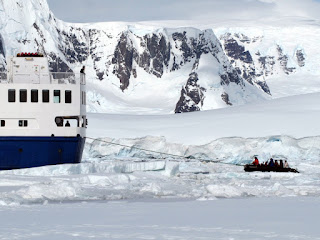
Having successfully stepped onto the shore of Antarctica our cruise made its way back across the swelling waters of the Bransfield Strait. Once again most of us retired early for the night as the rolling boat played havoc with our senses. However, just prior to entering the main strait the captain made a brief detour through a narrow scenic passage called the Friera Channel. It was here that we enjoyed the most memorable sunset of our entire cruise.
The following morning we woke early to witness our ship entering the narrow entrance of Foster Bay at Deception Island. The bay is actually the sunken caldera of an active volcano. Deception Island last erupted in 1963, destroying part of a British research base at Whalers Bay. The base was evacuated and has remained abandoned ever since. Our ship dropped anchor in the bay shortly before 8am after carefully making its way through the caldera's treacherous fog-shrouded entrance.
After breakfast we boarded the zodiacs and made our way ashore. We then spent several hours exploring the rusting remains of a Norwegian whaling station and the British research base. The island once boasted an active airfield. Today all the remains of this facility is a large, decaying aircraft hanger which also marks the boundary of a nature reserve closed to visitors.
We reversed our path and made our way back along the shore past abandoned wooden boats and sun-bleached whale boats towards a low ridge on the edge of the island. On a clear day this ridge, called Neptune’s Window, affords a glimpse of the Antarctic peninsula. Historians believe that the first conclusive sighting of the mainland was made by explorers from this vantage point.
Mid-morning we set sail again for Half Moon Island, a small crescent of rock located off the coast of the South Shetland Islands. We ventured ashore again to watch Chinstrap penguins nesting among the rocks. Once again we were lucky enough to watch the birds feeding their young or incubating their precious clutch of eggs – usually no more than two eggs. It was here we also saw our first, and only, Maraconi penguin on the entire cruise. These birds can be identified by a series of prominent yellow feathers on either side of their head.
We then set sail for Maxwell Bay on King George island thus marking the end of our cruise itinerary – or so we thought. As I’ve posted earlier, low cloud and fog prevented our return flight from landing for another three days and so our Antarctic adventure continued on into the New Year.




























































